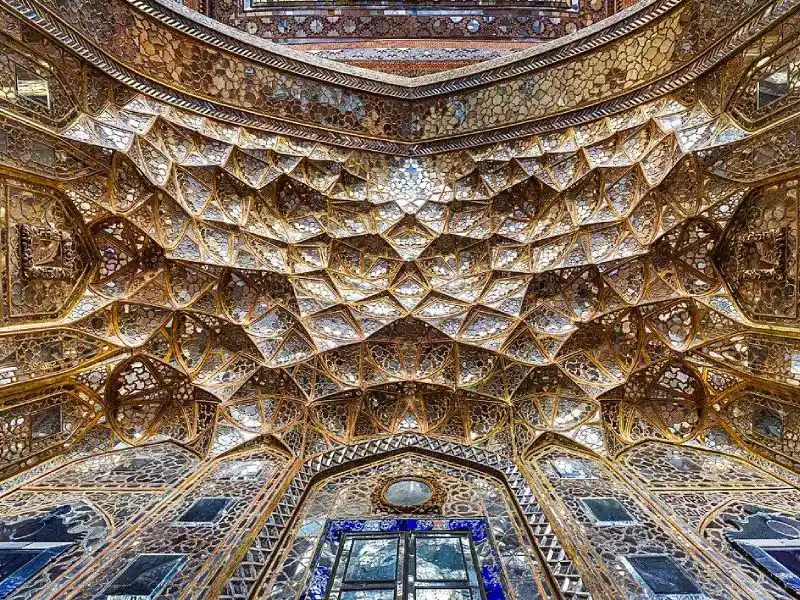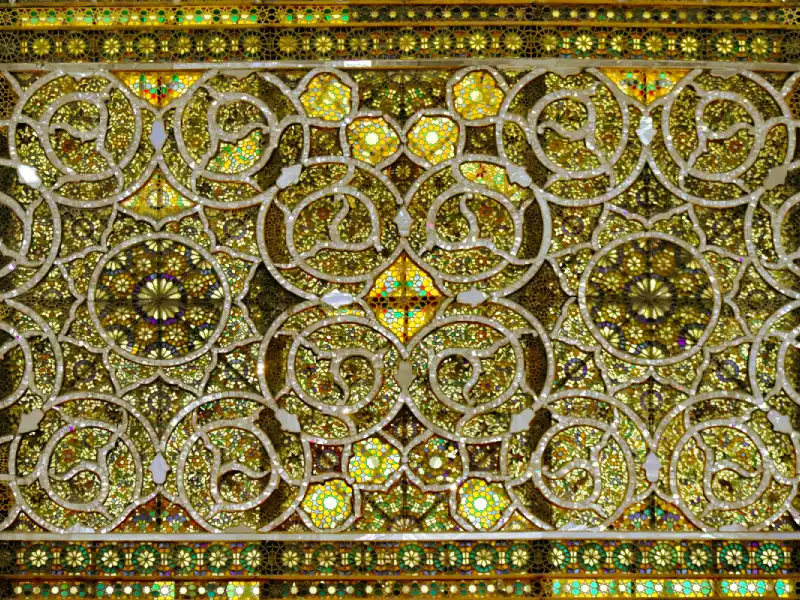Aina Kari, also known as Persian mirror art, is a time-honored decorative technique from Iran that elevates mirrors into extraordinary art pieces. This meticulous craft involves intricate cutting and arranging of tiny mirror fragments into geometric and floral designs, creating stunning reflections and kaleidoscopic patterns. For centuries, Aina Kari has adorned the interiors of palaces, mosques, and historic structures in Iran, infusing these spaces with a sense of luxury and brilliance. Deeply rooted in Persian culture and artistry, this unique craft embodies the beauty and precision of Iranian workmanship, making it a cherished aspect of the nation’s cultural heritage. Let’s delve deeper into the enchanting world of Persian mirror art!
The History of Persian Mirror Art
The origins of Persian mirror art trace back to the 16th century during the Safavid era, a time when the Persian Empire experienced a flourishing of art, culture, and architecture. The practice, known as Aina Kari, was introduced in Iran with the arrival of European mirrors.
Initially, large sheets of mirrors were imported, but many broke during transport. Rather than discarding the fragments, skilled Persian artisans ingeniously transformed these remnants into detailed patterns, giving rise to a distinctive art form that became synonymous with Persian architectural elegance.
Aina Kari gained prominence in the Qajar period (late 18th to early 20th century), where it was favored by royalty to decorate palaces and significant buildings. The intricate, reflective nature of mirror work symbolized wealth, power, and divine beauty, making it a preferred choice for royal decoration.
Persian Mirror Art at Golestan Palace
During this era, the art form evolved as artisans experimented with intricate geometric patterns and floral designs. Each mirror piece was precisely cut and arranged to create captivating visual effects, brightening and expanding the perception of interior spaces.
Some of the most renowned examples of Persian mirror art can be found in the Golestan Palace in Tehran, specifically the Hall of Mirrors (Talar-e Ayeneh), which showcases some of the finest Aina Kari work in the country. Other notable sites include the Narenjestan Qavam in Shiraz and the Ali Qapu Palace in Isfahan, where intricate mosaics reflect the artistic mastery of Persian artisans, offering a glimpse into the magnificence of Iran’s architectural legacy. The enchanting allure of Persian mirror art continues to inspire and captivate audiences, preserving its status as one of Iran’s most treasured cultural artifacts.
The Style of Persian Mirror Art
The style of Persian mirror art is celebrated for its complex geometric patterns and elegant floral motifs, achieved through the meticulous arrangement of tiny mirror fragments. This art form requires exceptional craftsmanship, with artisans employing precise cutting techniques to design symmetrical shapes.
The mirrors’ reflective surfaces amplify light, creating a spellbinding, almost magical ambiance in spaces adorned with this art. These patterns often harmonize with other traditional Persian decorative forms such as tile work and stucco, seamlessly combining art forms to enhance architectural beauty.
One of the defining features of Persian mirror art is its transformative ability to turn ordinary rooms into spectacular environments that feel spacious and luminous. The strategic placement of mirrors reflects light in various directions, generating an atmosphere of luxury and opulence. This style has been prominently featured in royal palaces, mosques, and esteemed cultural landmarks throughout Iran.
The precision and inventiveness of Persian mirror art continue to influence contemporary artists and designers, who draw inspiration from this timeless technique in modern architectural projects, thus keeping its legacy alive.
Persian Mirror Art Patterns
The elaborate geometric designs characteristic of Persian mirror art patterns often take inspiration from nature and Islamic artistic traditions. Artisans carefully position small mirror fragments to form symmetrical designs, including stars, flowers, and intricate interlocking patterns.

Persian Mirror Work in Chehel Sotoun
These designs not only enhance the visual appeal but also embody symbolic significance, reflecting the harmony and balance inherent in nature and the cosmos. The strategic placement of mirror fragments facilitates light reflection from diverse angles, producing a dynamic and luminescent effect that enhances architectural beauty.
A remarkable example of these intricate patterns can be observed in the Chehel Sotoun Palace in Isfahan, where the remarkable mirror work adorns the Hall of Mirrors, transforming it into a brilliant display of light and reflection.
The mirror mosaics within Chehel Sotoun are arranged in delicate floral and geometric patterns, capturing and scattering light to illuminate the space with an otherworldly glow. This masterful application of mirror art underscores the exceptional skills of Persian craftsmen and highlights how mirror work has been an essential element of Iranian architectural heritage.
Persian Mirror Work
Persian Mirror Work, or Aina Kari, holds immense significance in Persian culture and history, symbolizing beauty, craftsmanship, and artistic innovation. For centuries, this intricate art form has embellished palaces, mosques, and cultural landmarks, reflecting the opulence and refinement of Persian architecture.
The dazzling nature of mirror work is not only aesthetically captivating but also imbued with deeper symbolic meanings in Persian culture, where light is frequently associated with spirituality and divine presence. By casting light in mesmerizing patterns, Persian Mirror Work fosters a sense of harmony and tranquility, enhancing both the visual and spiritual ambiance of a space.
This enduring tradition found within Iran’s most iconic structures demonstrates the nation’s profound appreciation for art, craftsmanship, and the preservation of its rich cultural legacy.
Safavid Glass & Mirror Work
During the Safavid era, the art of glass and mirror work thrived, marking a pivotal moment in Persian decorative arts. Mirrors, initially imported from Europe, became luxurious items reserved for royalty and the elite. Throughout the Safavid period, mirror work represented not only wealth and power but also a reflection of divine light, mirroring the Safavid dynasty’s profound spiritual beliefs.

Persian Mirror Art Style
The fragmented mirrors were artistically arranged into geometric and floral designs, often embodying notions of cosmic order and harmony, merging aesthetic beauty with symbolic depth. This mirror work served as a visual metaphor for the celestial realm, illuminating spaces with light believed to bridge the material and spiritual worlds.
Final Thoughts
Persian Mirror Art showcases the extraordinary skill and artistry of Iranian craftsmen, merging beauty with cultural and spiritual significance. This intricate art form, which originated from the creative reimagining of broken mirrors, has evolved over the centuries to become a symbol of luxury, light, and harmony. Present in some of Iran’s most iconic palaces and sacred buildings, Persian Mirror Art not only enhances the architectural beauty of these structures but also reflects the profound connection between Persian culture, craftsmanship, and the divine. Its lasting presence continues to enchant admirers, securing this unique art form as an integral part of Iran’s vibrant cultural heritage.
Are you planning a trip to Iran and looking for a reliable travel agency? Explore our incredible Iran tours.



